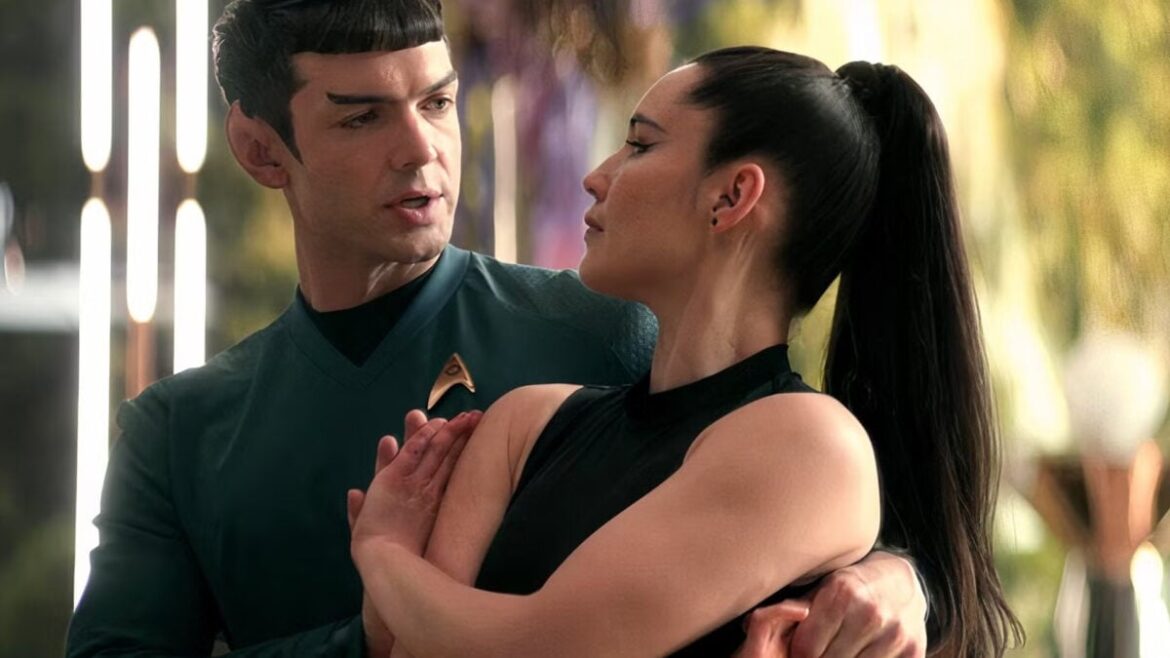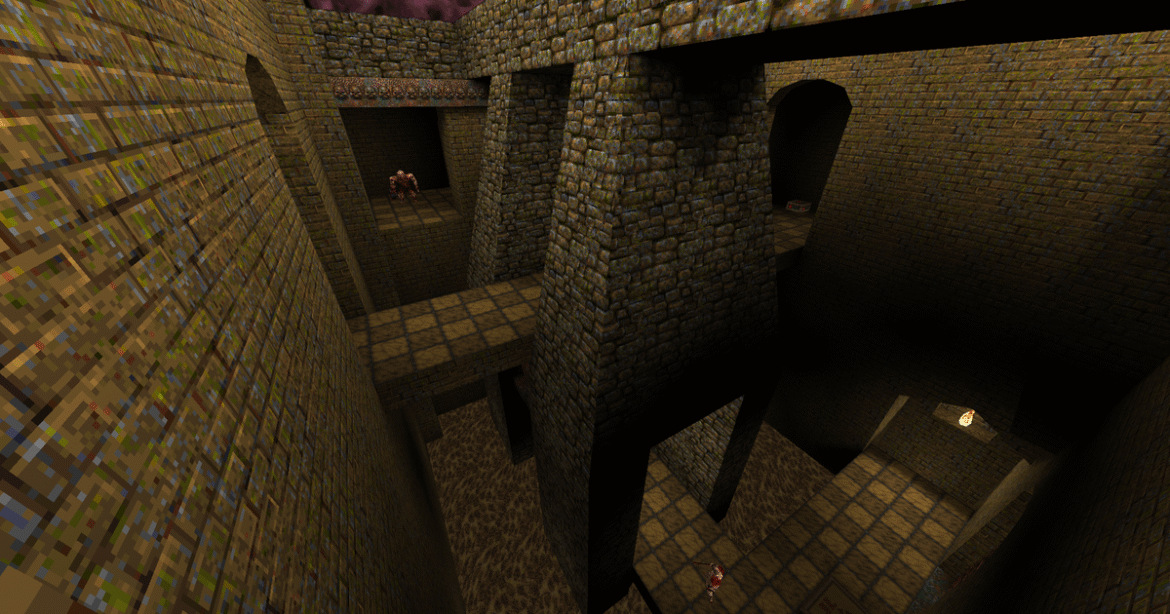Star Trek‘s utopian vision for an equal society, especially in terms of gender equality, has always been a complicated aspect of its idealized vision. It’s true that the franchise has a legacy of beloved, nuanced female characters and has championed putting those characters in the spotlight over six decades of storytelling. But it’s equally true that Star Trek‘s often conservative vision of women in leadership roles, as figures of desire, and as beholden to the stories of male characters has sat hand in hand with that feminist progressivism.
There are perhaps, however, few individual seasons of Star Trek from the past 60 years that reflect that dichotomy more than Strange New Worlds‘ recently concluded third.
On paper, Star Trek: Strange New Worlds arguably has one of the largest groups of female characters in its primary cast. Of the current main crew, just four of the show’s central characters are men—Pike, Spock, M’Benga, and this season’s addition of Martin Quinn as the younger Montgomery Scott—in comparison to six women: Una, Uhura, La’an, Ortegas, Chapel, and Pelia. That gap has only grown over the course of the show’s life, with Pelia replacing former chief engineer Hemmer after season one, and even the increased prominence of guest characters like Paul Wesley’s young Jim Kirk has been balanced by an increasingly prominent role for Melanie Scrofano’s Marie Batel (especially this season, as we’ll get into).
© Paramount
Those female characters have also served to facilitate some of Strange New Worlds‘ standout episodes and arcs thus far as well. Uhura’s initial focus as the new perspective aboard the Enterprise in season one flourished across episodes like “Children of the Comet” or in her mentee relationship with Hemmer. La’an’s history with the Gorn played a significant role in Strange New Worlds‘ characterization of the species (for better or worse), and she was given space to process both that and, in episodes like “Tomorrow and Tomorrow and Tomorrow“, her complicated relationship to Khan and the Augments. Una’s revelation of her Illyrian heritage was made a climactic point in the final moments of the show’s first season, leading to a character-defining turn for actress Rebecca Romijn in the season two episode “Ad Astra Per Aspera“.
But, at times, those female characters were also underserved in those first two seasons—a problem exacerbated by season three, rather than wholly created by it. Nurse Chapel’s arc in the first two seasons largely hinged on her will-they-won’t-they relationship with Spock, fizzling out almost immediately after the two were allowed to get together (shortchanging another great female character in Spock’s Vulcan fiancee, T’Pring, played by guest star Gia Sandhu). Ortegas, meanwhile, was regularly criticized for never really getting her own moment to shine in the show, constantly seeking a storyline outside of a perfunctory exploration of her role as the Enterprise helmsperson (a frustration compounded by the fact that the character, a veteran of Discovery‘s Klingon-Federation war, was only ever allowed to be aggressively distrusting of Klingons or other alien species or simply say things like “I fly the ship”).
Unfortunately, of the various factors that led to Strange New Worlds‘ third season failing to come even close to the mark left by seasons one and two—an experimental breadth of tone and genre leading to more misses than swings, an overreliance on connection to Star Trek‘s past, and an ongoing issue of its episodic format increasingly being in friction with the show’s character work, among other things—one that stood out the most was that these prior issues the show had with underserving some of its female characters suddenly began impacting almost all of them.
© Paramount
Across its third season, it has consistently felt like Strange New Worlds has had little idea of where it wanted to take its characters, but especially so with its female ones. Prior arcs like La’an’s traumatic history with the Gorn were dropped or shuffled onto other characters: Ortegas sustains a nearly fatal injury from a Gorn attack in the season’s premiere, setting her up to take on that arc instead, to mixed results—it’s not touched on notably until the penultimate episode of the season, “Terrarium,” in which she’s forced to work with a similarly stranded Gorn pilot, but Erica’s attitude towards hostile species and her own traumatic memory of her injury are almost immediately dropped in the episode with little examination as to why.
Una’s relationship as an Illyrian, a genetically modified humanoid who won legal precedent against Starfleet’s rules against such species being part of the Federation, manifested less as an arc for her and more as a plot device when she essentially became a “magic blood” donor to save Captain Batel’s life.
And then what was continued, or introduced to serve as replacements to those prior character arcs, was almost unified across the majority of the series’ female characters: romantic relationships with men. Almost as soon as she was broken up with Spock, season three introduced Cillian O’Sullivan as Chapel’s new love interest (“new” in that it connected up with her eventual status quo in classic Star Trek) Dr. Korby, with her time in the series largely less about exploring herself and her own agency and more about how her relationship furthered the characters of the men she was romantically involved with. Even more immediately, after Spock’s breakup with Chapel, he was paired with La’an, a move that narratively came out of nowhere and was only largely sold by Christina Chong and Ethan Peck’s chemistry—and again, was more in service to Spock’s character than it was necessarily to La’an or her own agency in the matter.
Even Una and Uhura couldn’t escape this heteronormative focusing either. Uhura was casually paired up with Ortegas’ newly introduced brother Beto (Mynor Lüken) here and there throughout the season, only for their burgeoning relationship to seemingly fizzle out and not be picked up again after the one-two tonal misfires of “What Is Starfleet?” and “Four and a Half Vulcans.” That latter episode, among its many issues, couldn’t even resist also capturing Una in Strange New Worlds‘ obsession with romance, giving her second-most-prominent arc in the season over to an extended gag about a prior, sexually intense relationship with Patton Oswalt’s guest-starring role as the human-obsessed Vulcan Doug.
© Paramount
It’s not even that a romance plotline is inherently a bad thing. The real issue is the fact that Strange New Worlds seemingly only had the idea to do one with the bulk of its female stars this season over giving them any other kind of arc. The only characters that escaped that framing were Pelia, who almost entirely exists as an excuse (a delightful one, at that) for Carol Kane to make one gag after another, and Ortegas, whom the show still struggles to do anything with, romantic or otherwise. And ultimately, all of these romantic arcs have been less about the autonomy of their female halves and instead in service of forwarding the arcs of the men in their lives, further stagnating their characters across the season.
This climaxes and is most obliquely symbolized in the season’s final episode, “New Life and Civilizations,” putting the spotlight on the culmination of Captain Batel and Captain Pike’s romantic relationship. Strange New Worlds had done very little with Batel in its first two seasons outside of her role as Pike’s love interest, outside of endangering her in the Gorn attack that straddled season two’s end and season three’s beginning (season three, again, largely sidelined her for her recovery, focusing on the impact of her situation on Pike instead), but the season three finale placed their relationship at the forefront of the show’s emotional climax. In doing so, it was again less about Batel and who we knew her to be as an individual and more about defining the fact that she was Pike’s girlfriend.
The dramatic thrust of the finale sees Batel confronted with the (largely out of nowhere) revelation that she is the subject of a predestination paradox where she is fated to become a crystallized statue sealing an ancient evil race called the Vezda for all eternity. But instead of centering her own concerns and fears about taking on that mantle—she’d almost literally just been given back her job at Starfleet’s judicial division after a season of fighting to be put back into service—the episode’s emotional throughline becomes almost entirely about Batel ensuring Pike that he’s going to be fine without her (she is almost too keen to essentially sacrifice herself in comparison), leading to an extended dream sequence where she uses her newfound guardian abilities to essentially speedrun Pike through a hypothetical future where they grow old and raise a child together before she is crystallized and, essentially for the series, removed as an ongoing character.
© Paramount
This was, ultimately, Batel’s most prominent appearance in Strange New Worlds, and it not only didn’t really further our understanding of her character, but it was almost entirely framed through the perspective of Pike’s emotional journey and narrative in regard to his own predestined fate.
As Strange New Worlds draws closer and closer to its own conclusion—just 16 episodes of the series remain across its final two seasons, or around two-thirds of one season of a classic Star Trek show—it’s damning that seemingly one of the few ideas it can have for its female characters is defining their arc in relationship to a man. With the time it has left, one of the lessons the series must take to heart is to better explore the wealth of opportunities its breadth of female characters can provide, instead of pigeonholing them into the same arc over and over.
Want more io9 news? Check out when to expect the latest Marvel, Star Wars, and Star Trek releases, what’s next for the DC Universe on film and TV, and everything you need to know about the future of Doctor Who.



